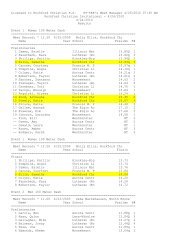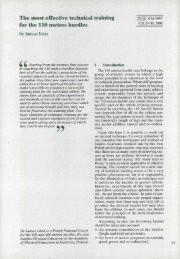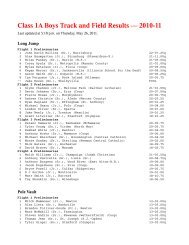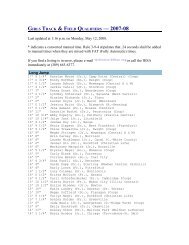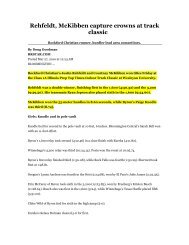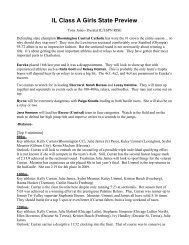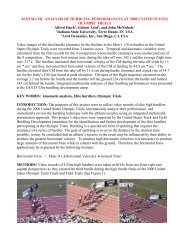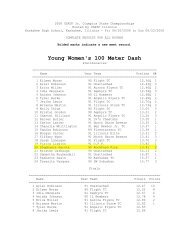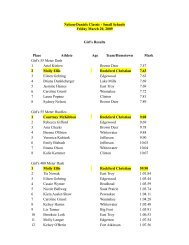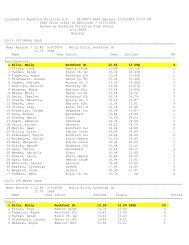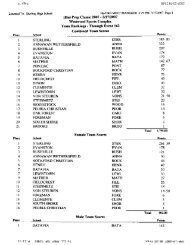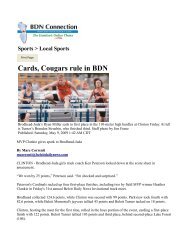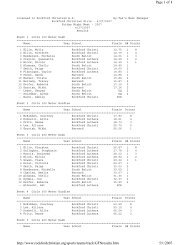Officiating Track & Field - HurdleCentral.com
Officiating Track & Field - HurdleCentral.com
Officiating Track & Field - HurdleCentral.com
Create successful ePaper yourself
Turn your PDF publications into a flip-book with our unique Google optimized e-Paper software.
USA <strong>Track</strong> & <strong>Field</strong><br />
Wel<strong>com</strong>es You to<br />
<strong>Officiating</strong> <strong>Track</strong> & <strong>Field</strong><br />
Courtesy of FinishLynx ®<br />
USATF National <strong>Track</strong> & <strong>Field</strong> Officials Committee<br />
Prepared by Lawrie G. Robertson, Peter J. L. Thompson and Eric D. Zemper, Ph.D.<br />
© USATF National Officials Committee 2000-2004
Clinic Schedule<br />
9:00 Wel<strong>com</strong>e, Goals, Introductions<br />
9:10 USATF Certification Process<br />
9:20 Philosophy of <strong>Officiating</strong><br />
9:25 Event Planning and Management<br />
9:35 <strong>Officiating</strong> the <strong>Track</strong> Events<br />
11:20 Introduction to <strong>Officiating</strong> <strong>Field</strong> Events<br />
11:35 <strong>Officiating</strong> the Jumps<br />
12:15 Lunch Break<br />
1:00 <strong>Officiating</strong> the Throws<br />
2:00 <strong>Officiating</strong> Other Areas (RW, LDR,<br />
Disabled)<br />
2:30 Summary, Questions, Next Steps<br />
3:00-5:00 USATF written rules review<br />
© USATF National Officials Committee 2000-2004
Clinic Goals<br />
• Promote an “athlete-centered” philosophy<br />
of officiating<br />
• Identify effective officiating techniques<br />
• Gain new skills and insights<br />
© USATF National Officials Committee 2000-2004
Clinic Goals<br />
• Understand key differences<br />
in rules<br />
• Develop a proactive<br />
approach to ensure fairness<br />
• Vision of an ongoing process<br />
necessary to develop skills &<br />
experience<br />
• To keep this volunteer<br />
activity fun<br />
© USATF National Officials Committee 2000-2004
<strong>Track</strong> & <strong>Field</strong> Acronyms<br />
• NFSHSA<br />
• NCAA<br />
• USATF<br />
• IAAF<br />
National Federation of State<br />
High School Associations<br />
National Collegiate Athletic<br />
Association<br />
USA <strong>Track</strong> & <strong>Field</strong><br />
International Association of<br />
Athletics Federations<br />
In the U.S. there are four different rule books we deal with,<br />
one from each of the above organizations<br />
© USATF National Officials Committee 2000-2004
USATF Certification Levels<br />
• Association<br />
• National<br />
• Master<br />
• Master Referee<br />
• National Technical Official (IAAF)<br />
© USATF National Officials Committee 2000-2004
The Primary Concern at All<br />
Times for all Officials is:<br />
SAFETY!<br />
© USATF National Officials Committee 2002-2004
The Golden Rule for <strong>Track</strong> Officials:<br />
No athlete should be allowed to gain<br />
an unfair advantage, and no athlete<br />
should have to suffer an unfair<br />
disadvantage.<br />
© USATF National Officials Committee 2002-2004
What Is an “Athlete-Centered”<br />
<strong>Officiating</strong> Philosophy ?<br />
• Proper application of rules to situation<br />
– Fairness<br />
– Objectivity<br />
– Impartiality<br />
• Reports observations, never affects the<br />
<strong>com</strong>petition<br />
• Consistent and clear <strong>com</strong>munications<br />
• Positive proactive approach<br />
(including preventive officiating)<br />
• Professionalism, integrity and teamwork<br />
© USATF National Officials Committee 2000-2004
An Effective Official Is :<br />
• Knowledgeable<br />
• Systematic and aware<br />
• Caring, but firm and consistent<br />
• Congenial, but impartial<br />
• Calm and <strong>com</strong>posed<br />
• Well groomed in appropriate uniform<br />
• “Invisible”<br />
• Able to see officiating as art and science<br />
© USATF National Officials Committee 2000-2004
Self-evaluation Check for Officials<br />
If you can leave the meet unnoticed,<br />
your job has been well done.<br />
(The attention should always be on the athletes.)<br />
© USATF National Officials Committee 2002-2004
An Effective Official is Prepared<br />
Heat<br />
– Sunscreen<br />
– Hat<br />
– Water or cool drink<br />
Cold<br />
– Gloves and hand warmer<br />
– Waterproofs and hat<br />
– Boots<br />
– Water or warm drink<br />
Snack<br />
“A A <strong>com</strong>fortable official is an effective official”<br />
© USATF National Officials Committee 2000-2004
Event<br />
Planning<br />
and<br />
Management<br />
© USATF National Officials Committee 2000-2004
© USATF National Officials Committee 2000-2004<br />
Organization of Meet Personnel<br />
Meet Director<br />
Jury of Appeals<br />
<strong>Track</strong> Referee<br />
<strong>Field</strong> Referee<br />
Starter<br />
Race Walk Referee<br />
Chief Clerk<br />
Chief Finish Judge Chief Umpire Chief <strong>Field</strong> Judge
<strong>Officiating</strong> Tasks Assignment Sheet<br />
Me e t: Date: Officials Coord.<br />
<strong>Track</strong> Referee Walk Referee <strong>Field</strong> Referee<br />
Starter Recaller Recaller<br />
Chief Clerk Assistant Clerk Assistant Clerk<br />
Chief Finish Judge Chief Umpire Chief <strong>Field</strong> Judge<br />
Place Finish Judge Umpire Area # Imple me nt We ig h-in<br />
1<br />
2 Wind Gaug e (Trac k)<br />
3 Wind Gaug e (Fie ld)<br />
4 Long Jump Chief<br />
5<br />
6<br />
7 Triple Jump Chief<br />
8<br />
9<br />
10 High Jump Chief<br />
11<br />
12<br />
13 Pole Vault Chief<br />
14<br />
15<br />
16 Hammer Chief<br />
Chief Timer<br />
Finish Line Coord.<br />
Place Timer Watch # Photo Panel<br />
Javelin Chief<br />
Chief Judge<br />
Race Walk Judge Jud. # Shot Put Chief<br />
1<br />
2<br />
3 Discus Chief<br />
4<br />
5<br />
6<br />
Lap S c o re Chie f<br />
Disqualification Board<br />
© USATF National Officials Committee 2000-2004
Role of Meet Director and<br />
Games Committee<br />
• Coordinate sub<strong>com</strong>mittees<br />
• Promote event and secure sponsors<br />
• Process entries and prepare event<br />
sheets<br />
• Recruit and manage sufficient officials<br />
• Secure needed equipment<br />
• Prepare facility for <strong>com</strong>petitions<br />
• Record and distribute results<br />
© USATF National Officials Committee 2000-2004
Role of the Referee<br />
• Overall responsibility for the meet<br />
• Supervises all chief officials<br />
• Reviews reports of officials concerning<br />
possible violations and takes action<br />
• May reschedule or add events in<br />
consultation with the Meet Director<br />
• Serves as a non-voting member of the<br />
Jury of Appeals<br />
© USATF National Officials Committee 2000-2004
<strong>Officiating</strong> <strong>Track</strong> Events<br />
© USATF National Officials Committee 2000-2004
Keeping the Meet on Schedule<br />
Announcer Clerk Starter Finish Area<br />
© USATF National Officials Committee 2000-2004
Clerk of the Course Duties<br />
• Know the facility<br />
• Assign <strong>com</strong>petitors to heats and lanes<br />
• Provide starting and advancing instructions<br />
• Proactively checks uniforms<br />
• Gather, hold, escort and place in lanes<br />
• Anticipate and resolve challenges<br />
• Attend to keeping the meet on schedule<br />
• Remain calm and organized<br />
© USATF National Officials Committee 1999-2004
Know the Facility<br />
Starting Line Locations and Markings<br />
© USATF National Officials Committee 2000-2004
Clerk of the Course Duties<br />
Assign Competitors to Heats and Lanes<br />
© USATF National Officials Committee 2000-2004
Assigning Heats and Lanes<br />
Trials Serpentining<br />
(Example of 3 Heats)<br />
Fastest<br />
Slowest<br />
1-2-3-4-5-6-7-8-9-10-11-12-13-14-15-16-17-18-19-20-21<br />
Competitors advance by taking places 1 - 4 from each heat<br />
plus 4 fastest times from all heats = 16 to semi-final<br />
© USATF National Officials Committee 1999-2004
Assigning Heats and Lanes<br />
Semi-final Rounds<br />
Selecting Semi-Finalists<br />
Serpentining by Place & Time<br />
Establishing Lanes<br />
Random “Double Draw”<br />
Semi-Final #1 Semi-Final #2<br />
1 H1 - 1st 1 H2 - 1st<br />
2 H1 - 2nd 2 H3 - 1st<br />
3 H2 - 2nd 3 H3 - 2nd<br />
4 H2 - 3rd 4 H1 - 3rd<br />
5 H3 - 3rd 5 H1 - 4th<br />
6 H3 - 4th 6 H2 - 4th<br />
7 NFT 1 7 NFT 2<br />
8 NFT 4 8 NFT 3<br />
Assigning Lanes<br />
(for each heat)<br />
1 2 3 4 5 6 7 8<br />
4 fastest from<br />
heats draw for<br />
lanes 3 - 6.<br />
4 slowest from each heat are randomly<br />
drawn for lanes 1, 2, 7 & 8<br />
© USATF National Officials Committee 1999-2004
Assigning Heats and Lanes<br />
Final<br />
• Qualify for the finals by<br />
taking the first 4 placers<br />
from each heat<br />
• Draw lanes by lot<br />
assigning 4 fastest<br />
finishers in lanes 3, 4, 5,<br />
and 6; the 4 slowest in<br />
lanes 1, 2, 7, and 8<br />
Assigning Lanes<br />
(for each heat)<br />
1 2 3 4 5 6 7 8<br />
4 fastest from<br />
heats draw for<br />
lanes 3 - 6.<br />
4 slowest from each heat are randomly<br />
drawn for lanes 1, 2, 7 & 8<br />
Note: High School events<br />
randomly assign lanes in pairs<br />
© USATF National Officials Committee 1999-2004
Clerk of the Course Duties<br />
Provide Instructions on Advancing<br />
© USATF National Officials Committee 1999-2004
Clerk of the Course Duties<br />
Gather, Check Uniforms and Escort<br />
Issue Hip<br />
Numbers<br />
Check<br />
Uniforms<br />
Escort to<br />
Start Line<br />
© USATF National Officials Committee 1999-2004
© USATF National Officials Committee 2000-2004<br />
The<br />
Starter
Qualities of a Good Starter<br />
• Is knowledgeable and decisive<br />
• Provides brief, concise instructions<br />
• Is firm, patient and fair<br />
• Possesses <strong>com</strong>mon sense and tact<br />
• Creates/maintains calm atmosphere<br />
at the starting line<br />
• Keeps meet on schedule<br />
• Shares leadership tasks - delegates<br />
• Works as part of a team<br />
• Keeps the focus on athletes<br />
© USATF National Officials Committee 2000-2004
Position of<br />
Starter and<br />
Recall<br />
For Staggered<br />
Lanes Starts<br />
© USATF National Officials Committee 2000-2004
Starting<br />
Straightaway<br />
Sprints<br />
© USATF National Officials Committee 2000-2004
Position of Starter<br />
800m and Longer<br />
Step Up Line<br />
Start Line<br />
© USATF National Officials Committee 1999-2004
False Start Rules<br />
• No false start rule (HS and college)<br />
• One false start rule or ‘One to the <strong>Field</strong>’<br />
(IAAF and USATF)<br />
• Two false start rule (for Combined<br />
Events, Youth and Masters)<br />
© USATF National Officials Committee 2003-2004
UMPIRES<br />
• “The eyes and ears of the Referee” Observe & report.<br />
• Umpires do not disqualify athletes; they report what<br />
they see to the Referee (and the Referee makes the<br />
decision).<br />
• If you see an infraction, raise the yellow flag and stay<br />
at your position until the Referee (or Chief Umpire)<br />
<strong>com</strong>es to you.<br />
• Be prepared to give a full (written) description of who<br />
did what to whom and when.<br />
• If you’re not sure, don’t make the call.<br />
• If you see a situation you know is not a foul, but there<br />
may be a question, write a report to pass on to the<br />
Referee.<br />
© USATF National Officials Committee 2000-2004
Umpiring<br />
How would you prioritize:<br />
if you have 4, 8, or 12 Umpires?<br />
© USATF National Officials Committee 1999-2004
Umpiring Positions - Prioritized<br />
4 8 3<br />
12<br />
5 10 9 6<br />
11<br />
1 7 2<br />
© USATF National Officials Committee 1999-20004
Umpire Tasks<br />
Minimum of 4 required<br />
- to cover curves,<br />
straights and relay<br />
exchange zones<br />
© USATF National Officials Committee 1999-2004
© USATF National Officials Committee 1999-2004<br />
Observe & Report Possible Violations<br />
• Impeding or jostling<br />
• Illegal hurdling – dragging or intentional knocking down<br />
• Unfair assistance or contact<br />
• Exchanging the baton beyond the relay exchange zone<br />
• Failing to run in a direct line on final straight<br />
• Running on or over inside lane line on a curve
Umpire Tasks<br />
Observe for and report if <strong>com</strong>petitor fails to<br />
clear the horizontal plane of a hurdle or<br />
intentionally knocking down a hurdle<br />
© USATF National Officials Committee 1999-2004
Steeple Chase Barrier<br />
Clearance Methods<br />
© USATF National Officials Committee 1999-2004
Relay Passes<br />
Baton Must Be Within the Zone<br />
end of zone<br />
end of zone<br />
© USATF National Officials Committee 1999-2004
Relay Passes<br />
Baton Must Be Within the Zone<br />
end of zone<br />
end of zone<br />
© USATF National Officials Committee 1999-2004
Umpire’s<br />
Observation<br />
Report<br />
Important Elements:<br />
Event<br />
Heat<br />
Lane<br />
Bib Number<br />
Reason<br />
Description of Incident<br />
Signature<br />
Decision<br />
Umpire’s Report of a Possible Infraction<br />
MEET: WIAA State Champions<br />
CLASS AAAA<br />
DATE: 5/30/99 TIME OF DAY: 3:00 PM<br />
EVENT: 400 Meters HEAT/SEMI NO. 2 of 2<br />
GIRLS / BOYS (circle) LANE NUMBER: 5<br />
COMPETITOR’S NAME: Samantha Johnson<br />
BIB NUMBER: 717 TEAM: Excell<br />
COLORS: JERSEY: Maroon and Gold<br />
SHORTS:<br />
Navy Blue<br />
LANE LINE X EXCHANGE ZONE ___ HURDLE ___<br />
VEERING ___<br />
JOSTLING/INTERFERENCE ___<br />
POSSIBLE INFRACTION SPECIFICS (mark diagram on back)<br />
(who/what/how/where) Athlete in lane 5 took 4 consecutive<br />
steps on or over the inside lane line of her assigned lane<br />
while running on the south curve .<br />
UMPIRE’S SIGNATURE: Lawrie Robertson<br />
LOCATION NO. 15 USATF CERT NO. 002679<br />
CHIEF UMPIRE’S SIGN.:<br />
Bob S pringer<br />
DECISION OF REFEREE (Rule No., Rule Book, Year, Page)<br />
By rule, the athlete shall be disqualified .<br />
Rule # 5-11-1-a pages 35 &36 of the 1999 Nation al<br />
Federation Rules Book.<br />
REFEREE’S SIGNATURE:<br />
Sally Tuffgal<br />
© USATF National Officials Committee 1999-2004
The Finish<br />
© USATF National Officials Committee 1999-2004
Finish Judges<br />
Finish Judges<br />
• Assigned to a place, NEVER to a lane<br />
• Stop the watch, identify placer, follow placer<br />
• Communicate immediately if problems occur<br />
• Don’t bluff; not a contest<br />
• Work as a team<br />
© USATF National Officials Committee 1999-2004
Competitors Timed and Placed<br />
to Near Edge of Finish Line<br />
Near<br />
Edge<br />
Direction of Athlete<br />
© USATF National Officials Committee 1999-2004
Time/Place Finishers Based on<br />
Position of the “Torso”<br />
Courtesy of FinishLynx ®<br />
Torso = Trunk<br />
NOT - head, neck, arms, hands, legs or feet<br />
© USATF National Officials Committee 1999-20004
Converting Hand Times<br />
• For track events - convert times to next<br />
higher 1/10th of a second<br />
– Time on watch = 10.43<br />
– Reported time is 10.5<br />
– Time on watch = 10.50<br />
– Reported time is 10.5<br />
• For races not fully on the track, convert times<br />
to next highest second; e.g., marathon:<br />
– Time on watch = 3:29:45.12<br />
– Reported time is 3:29:46<br />
© USATF National Officials Committee 1999-2004
Differences in Times<br />
• If 3 watches disagree, select the middle time<br />
• If 2 of 3 watches agree, select the time of the<br />
agreeing watches<br />
• If only 2 timers and they disagree, take the<br />
slower of the 2<br />
• Priority given to timer assigned to time the<br />
higher place<br />
• Important to have back up timer<br />
© USATF National Officials Committee 1999-2004
Fully Automatic Timing - F.A.T.<br />
(Courtesy of FinishLynx ® )<br />
Courtesy of FinishLynx ®<br />
© USATF National Officials Committee 1999-2004
In Summary<br />
• Organize to keep meet on<br />
schedule<br />
• Work as a team<br />
• Use written task descriptions<br />
• Secure enough officials to<br />
time, place and observe<br />
each <strong>com</strong>petitor<br />
• Be as “invisible” as possible<br />
© USATF National Officials Committee 1999-2004
<strong>Officiating</strong> <strong>Field</strong> Events<br />
© USATF National Officials Committee 2000-2004
SAFETY!<br />
Your Most Important Consideration<br />
in <strong>Officiating</strong> <strong>Field</strong> Events<br />
© USATF National Officials Committee 1999-2004
<strong>Officiating</strong> <strong>Field</strong> Events<br />
• Think Safety First!<br />
• Administer an organized event<br />
– Review rules prior to <strong>com</strong>petition<br />
– Provide clear and <strong>com</strong>plete instructions<br />
– Inspect all implements and <strong>com</strong>petitors<br />
– Assure accurate measurements<br />
– Create a fair <strong>com</strong>petition environment<br />
• Provide consistent calls:<br />
“Up”, “On deck”, “On hold”<br />
© USATF National Officials Committee 1999-2004
<strong>Officiating</strong> <strong>Field</strong> Events<br />
Time Limits for <strong>Field</strong> Events:<br />
-- Open -- -- Combined --<br />
# Remaining Throws/ HJ PV Throws/ HJ PV<br />
Greater than 3<br />
Horiz. J. Horiz. J.<br />
USATF/IAAF 1 1 1 1 1 1<br />
NCAA 1 1 1 1 1 1<br />
HS 1 1 1½ 1 1 1 ½<br />
2-3 Remaining<br />
USATF/IAAF 1 1½ 2 1 1½ 2<br />
NCAA 1 2 3 1 2 3<br />
HS 1 3 4 1 ½ 3 4<br />
1 Remaining<br />
USATF/IAAF 1 3 5 1 2 3<br />
NCAA 1 4 5 1 2 3<br />
HS 1 5 6 1 ½ 5 6<br />
Yellow warning flag at ¼ min. remaining for USATF/IAAF, at ½ min. for NCAA<br />
Consecutive attempts: generally 2 minutes, 3 minutes for PV<br />
© USATF National Officials Committee 1999-2004
Tips for Conducting<br />
Safe Competitions<br />
• Limit access to jumps and throws areas<br />
• HS rules require responsible adult<br />
supervision during warm-ups<br />
• Provide adequate time for warm-up, prior<br />
to (30 min.) and between flights (10 min.)<br />
• Closely supervise all warm-up activities<br />
• Use calls, rules and assertive leadership<br />
© USATF National Officials Committee 1999-2004
Tips for Conducting<br />
Safe Competitions<br />
• Practice throws within sectors only<br />
• Control access to implements (impound)<br />
• Check implements for damage (and for<br />
W/M ‘mark of the day’)<br />
• Walk all implements back, no tossing<br />
© USATF National Officials Committee 1999-2004
<strong>Officiating</strong> Horizontal Jumps<br />
Approach to <strong>Officiating</strong> <strong>Field</strong> Events<br />
© USATF National Officials Committee 2000-2004
Long/Triple Jump Positions<br />
© USATF National Officials Committee 1999-2004
Preparation - Assigning Officials<br />
• Match assignment with experience and<br />
skill<br />
• Assign the duties for entire event<br />
• Rotate positions between events<br />
© USATF National Officials Committee 1999-2004
Preparation - Minimum Coverage<br />
Competition requires at least 2 officials:<br />
• Judge 1 (Head Judge)<br />
– Call athletes<br />
– Judge the take-off board<br />
– Hold tape at right angle to foul line<br />
– Check and record distances<br />
• Judge 2 (Pit Judge)<br />
– Mark break in sand<br />
– Hold tape’s zero end at break point<br />
– Prepare pit for next <strong>com</strong>petitor<br />
© USATF National Officials Committee 1999-2004
Preparation - Essential Supplies<br />
• Fiberglass tape (20 meters)<br />
• Clipboard and Pencils<br />
• Stopwatch<br />
• Rake<br />
• Shovel<br />
• Broom<br />
• Access to water/hose<br />
© USATF National Officials Committee 1999-2004
Preparation - Higher Level<br />
Competitions<br />
• 50 Meter/100 foot metal or fiberglass tape<br />
• Wind gauge<br />
• Leveling bar<br />
• Plastic clipboard cover<br />
• Flags and cones<br />
• Clock<br />
• Seating for all officials<br />
• Plasticine, putty knife, roller, white polish<br />
• Towel<br />
© USATF National Officials Committee 1999-2004
Preparation - Readying the<br />
Competition Area<br />
• Check the board<br />
- condition and steadiness<br />
• Moisten the pit<br />
• Turn pit with shovel or roto-tiller, remove debris<br />
• Level pit<br />
• Sweep area around pit, clean the runway<br />
• Sweep and rake following warm-up period<br />
© USATF National Officials Committee 1999-2004
Long/Triple Jump<br />
Sand Break Points<br />
Requirement for a Level Pit<br />
© USATF National Officials Committee 1999-2004
<strong>Field</strong> Events Results Form<br />
© USATF National Officials Committee 1999-2004
Preparation - Wind Gauge<br />
• Place the gauge<br />
- 20 meters from foul line<br />
- 2 meters back from runway<br />
- 1.22 meters above ground<br />
• Record the wind reading<br />
for every attempt<br />
© USATF National Officials Committee 1999-2004
The Competition<br />
Warm-up and Run Through Period<br />
• Announce a specific time period allotted<br />
for open pit run-through practices<br />
• Supervise to maintain a safe pit<br />
• Close pit at the predetermined time -<br />
cone at board<br />
• Level and prepare the pit for the<br />
<strong>com</strong>petition<br />
• Ensure that no marks are placed on the<br />
runway<br />
© USATF National Officials Committee 1999-2004
The Competition<br />
Competitor Instructions<br />
• End warm-ups five minutes prior to start<br />
• Gather all <strong>com</strong>petitors<br />
• Review:<br />
– Applicable rules<br />
– Any special rules applying to this meet<br />
– Time limit per attempt (60 sec.) and calls<br />
– Procedures for checking out of the event<br />
– Order of jumps and method for advancing to<br />
the final<br />
© USATF National Officials Committee 1999-2004
The Competition<br />
Sample Competitor Instructions<br />
• “You will place no marks on the runway or<br />
in the pit”<br />
• “You have 1 minute after your name is<br />
called to initiate your attempt”<br />
• “You must exit the pit beyond your mark”<br />
• “You must check out with the head official<br />
before leaving for another event in<br />
preliminaries and return promptly”<br />
• “You may not leave during the finals”<br />
© USATF National Officials Committee 1999-2004
Take-off Board - Foul vs Fair<br />
© USATF National Officials Committee 1999-2004
Typical High School Board<br />
© USATF National Officials Committee 1999-2004
Triple Jump Technique<br />
© USATF National Officials Committee 1999-2004
Elements of a Valid Jump<br />
© USATF National Officials Committee 1999-2004
Types of<br />
Violations<br />
© USATF National Officials Committee 1999-2004
Long/Triple Jump Measurement<br />
Sand Break Points<br />
© USATF National Officials Committee 1999-2004
The Competition<br />
Proper Measurement<br />
• Mark closest point of landing to the board<br />
• Zero end of the tape is placed on the edge<br />
of the break in sand closest to the take-off<br />
board<br />
• Measure perpendicular to take-off board<br />
and parallel to the edge of runway<br />
• Announce distance to lesser centimeter, or<br />
“foul” as the red flag is raised after attempt<br />
is <strong>com</strong>plete<br />
© USATF National Officials Committee 1999-2004
Points of Measurement<br />
© USATF National Officials Committee 1999-2004
The Competition - The Final<br />
• Determine the <strong>com</strong>petitors who will advance<br />
The number should be on results sheet<br />
• Determine the order in the final<br />
• Announce names, order and preliminary<br />
marks<br />
• Announce final round, final attempt for each<br />
<strong>com</strong>petitor<br />
• Recheck results, sign, submit results<br />
• Leave <strong>com</strong>petition area in good condition<br />
© USATF National Officials Committee 1999-2004
The Competition<br />
Potential Problem Areas<br />
• Competitors jumping out of order<br />
• Jumpers checking in, then “disappearing”<br />
• Unacceptable language, behavior<br />
• People walking across the runway<br />
• Safe use and storage of equipment<br />
• Pit edge visible and surface kept level<br />
• <strong>Officiating</strong> crew in the proper positions<br />
• Conflicts with other events<br />
© USATF National Officials Committee 1999-2004
In Summary<br />
• Remove the cone<br />
• Make announcing calls:<br />
“Up” - “On deck” - “On<br />
hold”<br />
• Start the clock/watch<br />
• Watch the board for legal take-off<br />
• Signal “fair” or “foul”/”no mark”<br />
after the <strong>com</strong>petitor has exited the pit<br />
• Announce clearly, don’t shout<br />
© ALLSPORT 1998<br />
© USATF National Officials Committee 1999-2004
<strong>Officiating</strong><br />
Vertical<br />
Jumps<br />
© USATF National Officials Committee 2000-2004
Vertical Jump Tasks<br />
• Preparing area<br />
– Set standards and mark their placement<br />
– Set and mark the bar<br />
– Measure the height of crossbar at standard<br />
point<br />
• Time limit<br />
– 60 seconds (HS PV 90 sec.)<br />
• Clearance<br />
• Breaking ties<br />
© USATF National Officials Committee 1999-2004
Pole Vault Area<br />
0.80m<br />
0.40m<br />
Note: PV landing pad requirements are rapidly evolving; check<br />
your rule book for current dimensions. HS event not allowed if<br />
pad does not meet rule requirements.<br />
© USATF National Officials Committee 2000-2004
Pole Vault <strong>Officiating</strong> Positions<br />
© USATF National Officials Committee 1999-2004
Bar Placement<br />
and<br />
Measurement<br />
High Jump<br />
© USATF National Officials Committee 1999-2004
High Jump<br />
Observing<br />
the Bar<br />
© USATF National Officials Committee 1999-2004
<strong>Officiating</strong> Throwing Events<br />
© USATF National Officials Committee 2000-2004
Implements Inspection<br />
All throwing implements should be weighed and<br />
measured prior to the <strong>com</strong>petition<br />
© USATF National Officials Committee 1999-2004
Shot Put, Discus and Hammer<br />
<strong>Officiating</strong> Positions<br />
© USATF National Officials Committee 1999-2004
Shot Put and Discus<br />
Considerations<br />
Arc Angles:<br />
IAAF, USATF, NCAA:<br />
Shot put/Discus = 34.92º<br />
High School Federation:<br />
*Shot Put = 65.5º<br />
*Discus = 60º (outside the track)<br />
= 40º (inside the track)<br />
* State association may adopt 40º<br />
Sector Line<br />
© USATF National Officials Committee 1999-2004
Sector - Fair/Foul<br />
© USATF National Officials Committee 1999-2004
Shot Put Circle Fouls<br />
© USATF National Officials Committee 1999-2004
Hammer and Discus Cage<br />
Positions<br />
© USATF National Officials Committee 1999-2004
Javelin Throw<br />
<strong>Officiating</strong><br />
at the Arc<br />
© USATF National Officials Committee 1999-2004
Javelin Throw Measurement<br />
1. Point of contact<br />
1. Tape lies flat<br />
1. The “read” point<br />
2. Tape drawn through<br />
the center<br />
point<br />
© USATF National Officials Committee 1999-2004
In Review<br />
• Think and practice safety<br />
- in warm-ups and <strong>com</strong>petition<br />
• Consistent <strong>com</strong>munications and practices<br />
• Accuracy and athlete-centered<br />
© USATF National Officials Committee 1999-2004
<strong>Officiating</strong><br />
Long<br />
Distance<br />
Running<br />
and<br />
Cross<br />
Country<br />
© USATF National Officials Committee 2000-2004
<strong>Officiating</strong><br />
LDR and Cross Country<br />
• Referee/Race Director and Jury<br />
• Officials to cover<br />
– Start<br />
– Course<br />
– Finish<br />
– Results<br />
© USATF National Officials Committee 1999-2004
Course Design Issues<br />
• Registration Area<br />
– Overhead signs<br />
– Weather protection<br />
– Cut-off deadline for on-time start<br />
• Start Area<br />
– Safe, open, straight area for 600-800 meters<br />
– Arc and boxes for teams in cross country<br />
– Assembly line with rope across<br />
– Use of predicted pace signs (road races)<br />
© USATF National Officials Committee 1999-2004
Cross Country<br />
Course Design<br />
• Umpires<br />
• Course marshals<br />
• Split time readers<br />
• Spectator areas<br />
© USATF National Officials Committee 1999-2004
Start<br />
Procedure<br />
• Clerks - check in<br />
<strong>com</strong>petitors, set<br />
starting positions<br />
on start line - arc<br />
• Marshals - start line, assembly, pace signs<br />
• Starter - standard <strong>com</strong>mands, no count down<br />
© USATF National Officials Committee 1999-2004
On Course<br />
Issues<br />
• Course considerations:<br />
– Marking and signage<br />
– Splits – visual and oral<br />
– Aid stations – consistent organization<br />
– First aid and <strong>com</strong>munications<br />
– Marshaling and guiding<br />
• Applicable USATF rules on assistance and<br />
why umpires are important<br />
• Written procedures and process for major events<br />
• Role of the Event Director as Referee (not re<strong>com</strong>mended)<br />
© USATF National Officials Committee 1999-2004
Cross Country<br />
Finish Area<br />
System<br />
Chute 1 Open<br />
Direction of<br />
Finishers<br />
KEY<br />
Fixed Pennant<br />
Moveable Gate<br />
For Mass Finishes at<br />
Championship Events<br />
Timer and #<br />
Recorder FINISH LINE 2nd Timer and Random Timer<br />
A<br />
Place Caller/Director<br />
Sorter<br />
Sorter<br />
B<br />
40 Feet<br />
X<br />
Chute Aide<br />
Full Chute Point<br />
X<br />
X<br />
1 2 X 3<br />
X<br />
X<br />
80 Feet<br />
X<br />
X<br />
1 2 3<br />
X<br />
Quick Scorer --><br />
C D E<br />
© USATF National Officials Committee 1999-2004
Road Race Finish Systems<br />
© USATF National Officials Committee 1999-2004
LDR/Cross Country Finish Steps<br />
Finish<br />
• Chute Director<br />
• Recording Timers<br />
• Select Timers<br />
• Sorters<br />
• Chute Aides<br />
• Pullers<br />
• Spikers<br />
© USATF National Officials Committee 1999-2004
Results<br />
Generation Methods<br />
Total field finish times method<br />
– Finishers timed at the front of the chute<br />
– Tags removed from finishers at end of chute<br />
– Issues: “turkeys”, staying in chute, fallen finishers<br />
Estimated time method<br />
– All chutes open<br />
– Interval times taken<br />
– Time estimators sent down chutes<br />
– All tags removed<br />
© USATF National Officials Committee 1999-2004
Results Entry<br />
• Finisher tag information entered into<br />
<strong>com</strong>puter<br />
• Direct or indirect entry of times<br />
• Select times used to adjust recorded times<br />
© USATF National Officials Committee 1999-2004
<strong>Officiating</strong><br />
Race<br />
Walking<br />
© USATF National Officials Committee 2000-2004
Rules of Race Walking Technique<br />
• Rule # 1 The walker is to maintain<br />
continuous contact with the ground<br />
• Rule # 2 The walker’s advancing leg<br />
is to be straightened from first contact<br />
with the ground until the leg is in the<br />
vertical upright position<br />
© USATF National Officials Committee 1999-2004
Judging Sectors on <strong>Track</strong><br />
© USATF National Officials Committee 1999-2004
Proper Area of Observation<br />
48º<br />
© USATF National Officials Committee 1999-2004
Race Walk Caution Paddles<br />
Loss of Contact<br />
Bent Knee<br />
© USATF National Officials Committee 1999-2004
Recording<br />
Calls<br />
Process<br />
© USATF National Officials Committee 1999-2004
Race Walk Judge’s Cards<br />
Tally Sheet<br />
Warning Card<br />
© USATF National Officials Committee 1999-2004
Chief Judge’s Tally Sheet<br />
© USATF National Officials Committee 1999-2004
<strong>Officiating</strong> <strong>Track</strong> & <strong>Field</strong><br />
for Athletes with Disabilities<br />
© USATF National Officials Committee 2002-2004
<strong>Officiating</strong> <strong>Track</strong> & <strong>Field</strong><br />
for Athletes with Disabilities<br />
There are six Disabled Sports Organizations promoting T&F<br />
for disabled athletes:<br />
- Wheelchair Sports, USA<br />
- National Disability Sports Alliance (Cerebral Palsy)<br />
- Special Olympics<br />
- United States Association for Blind Athletes<br />
- USA Deaf <strong>Track</strong> & <strong>Field</strong><br />
- Disabled Sports USA (Amputee)<br />
All base their rules on IAAF and USATF rules, making<br />
modifications only as necessary to ac<strong>com</strong>modate the<br />
particular needs of the type of disability<br />
© USATF National Officials Committee 2002-2004
<strong>Officiating</strong> <strong>Track</strong> & <strong>Field</strong><br />
for Athletes with Disabilities<br />
• While Masters and<br />
Youth <strong>com</strong>petitions<br />
are grouped by<br />
age, disabled<br />
<strong>com</strong>petitions are<br />
grouped by age<br />
and by type and<br />
level of disability<br />
© USATF National Officials Committee 2002-2004
<strong>Officiating</strong> <strong>Track</strong> & <strong>Field</strong><br />
for Athletes with Disabilities<br />
Examples of rule modifications:<br />
- In wheelchair racing, the start and finish are determined<br />
by the hub of the front wheel<br />
© USATF National Officials Committee 2002-2004
<strong>Officiating</strong> <strong>Track</strong> & <strong>Field</strong><br />
for Athletes with Disabilities<br />
Examples of rule<br />
modifications:<br />
- In wheelchair<br />
racing, the relay<br />
exchange zones are<br />
doubled in length<br />
and two lanes are<br />
allowed per team<br />
© USATF National Officials Committee 2002-2004
<strong>Officiating</strong> <strong>Track</strong> & <strong>Field</strong><br />
for Athletes with Disabilities<br />
Examples of rule<br />
modifications:<br />
- In wheelchair racing,<br />
an athlete passing carries<br />
the responsibility of<br />
ensuring full clearance of<br />
the chair being overtaken,<br />
and the athlete being<br />
passed has the<br />
responsibility to not<br />
obstruct or impede once<br />
the front wheels of the<br />
passing athlete are in sight<br />
© USATF National Officials Committee 2002-2004
<strong>Officiating</strong> <strong>Track</strong> & <strong>Field</strong><br />
for Athletes with Disabilities<br />
Examples of rule modifications:<br />
For all running events, leg<br />
amputees must wear<br />
prostheses; but…<br />
for field events, they can wear<br />
them…<br />
or not wear them.<br />
© USATF National Officials Committee 2002-2004
<strong>Officiating</strong> <strong>Track</strong> & <strong>Field</strong><br />
for Athletes with Disabilities<br />
Examples of rule modifications:<br />
- When starting races for deaf athletes, the<br />
starter must use visual cues such as a flag or a<br />
strobe light<br />
- Blind athletes are allowed sighted guides in<br />
running events, do not have to use a baton in<br />
relays (exchange is by touch), and are allowed<br />
aural cueing in field events<br />
© USATF National Officials Committee 2002-2004
<strong>Officiating</strong> <strong>Track</strong> & <strong>Field</strong><br />
for Athletes with Disabilities<br />
<strong>Field</strong> events for<br />
wheelchair athletes<br />
involve the use of chair<br />
tie-downs or a throwing<br />
frame (maximum<br />
height of the seat is<br />
75 cm)<br />
© USATF National Officials Committee 2002-2004
<strong>Officiating</strong> <strong>Track</strong> & <strong>Field</strong><br />
for Athletes with Disabilities<br />
A <strong>com</strong>plete set of rule modifications<br />
for each disability group is in a<br />
special section of the USATF Rule<br />
Book, and in your clinic notebook<br />
© USATF National Officials Committee 2002-2004
<strong>Officiating</strong> <strong>Track</strong> & <strong>Field</strong><br />
for Athletes with Disabilities<br />
And…<br />
Persons with<br />
disabilities can<br />
be officials, as<br />
well.<br />
© USATF National Officials Committee 2004
Next Steps<br />
© USATF National Officials Committee 2000-2004
Next Steps to Certification<br />
Check for fees made out to:<br />
[insert appropriate info here]<br />
Complete data forms<br />
(two copies; <strong>com</strong>plete one, sign both)<br />
Complete the rules review(s)<br />
© USATF National Officials Committee 2002-2004
Next Steps to Certification<br />
Get started on <strong>com</strong>pleting the practicum<br />
Name of Candidate: Phone #: ( )<br />
Instructions: The Pacific Northwest Association requires that new officials serve in an apprentice role in 10<br />
different capacities at 10 separate meets over a two-year period. Of the ten meets, at least one must be from each of<br />
the following types of meets: a Youth or Masters meet, an Open meet, a High School meet, and a College/University<br />
meet. You are also urged to officiate at a Special Olympics or disabled athletes meet. You may <strong>com</strong>plete the tasks in<br />
any order, but please secure a sign-off from your supervising official at each <strong>com</strong>petition.<br />
Please Print All Information<br />
1. TASK: Serve as either a timer or finish judge (place picker).<br />
Name of Meet:<br />
Meet Type (check): Youth Masters Open High School College Disabled<br />
<strong>Officiating</strong> Task(s) Performed:<br />
Supervisor's rating/<strong>com</strong>ments:<br />
Date:<br />
Supervisor's Name:<br />
Signature:<br />
2. TASK: Serve as an assistant to the Clerk, Starter or Meet Scorer<br />
Name of Meet:<br />
Date:<br />
Meet Type (check): Youth Masters Open High School College Disabled<br />
<strong>Officiating</strong> Task(s) Performed:<br />
Supervisor's rating/<strong>com</strong>ments:<br />
Supervisor's Name:<br />
Signature:<br />
3. TASK: Serve as an Umpire (formerly known as Inspector )<br />
Name of Meet:<br />
Date:<br />
Meet Type (check): Youth Masters Open High School College Disabled<br />
<strong>Officiating</strong> Task(s) Performed:<br />
Supervisor's rating/<strong>com</strong>ments:<br />
Supervisor's Name:<br />
Signature:<br />
© USATF National Officials Committee 2000-2004
Continuing Education<br />
• This was a Level I clinic<br />
• There also are Level II clinics available, halfday<br />
in length and focused on specialty areas<br />
(e.g., race walk judging, starting, weights and<br />
measures, clerking, throws, jumps)<br />
• National and Master level officials are<br />
required to attend a minimum of one Level II<br />
clinic per Olympiad<br />
© USATF National Officials Committee 2002-2004
© USATF National Officials Committee 2000-2004<br />
National <strong>Track</strong> & <strong>Field</strong> Officials Committee of<br />
USA <strong>Track</strong> & <strong>Field</strong><br />
and the<br />
[Your] Association Officials Committee<br />
Wel<strong>com</strong>es You to <strong>Officiating</strong><br />
and<br />
Thanks you for attending today’s course
Go for it!<br />
© USATF National Officials Committee 2000-2004
ALLSPORT Photographs. 1998<br />
Acknowledgments<br />
Bakjian, A. <strong>Track</strong> Management. <strong>Track</strong> & <strong>Field</strong> News, Inc., Los<br />
Altos, CA. 1982<br />
Hickman, D. Race Walk Judging Handbook. USATF,<br />
Indianapolis, IN. 1991<br />
International Amateur Athletic Federation Technical Committee.<br />
Athletics <strong>Officiating</strong>: A Practical Guide. IAAF, London, UK. 1990<br />
Robertson, L.G., Kleeman, G., Thompson, P. J. L. A Guide to<br />
<strong>Track</strong> & <strong>Field</strong> <strong>Officiating</strong>. USATF, Indianapolis, Indiana, 1999<br />
Seese, Eddie, Photographs, Personal Record Sports, Vallejo,<br />
California, 1999<br />
Zemper, Eric D., Starters USATF Training Monograph<br />
For use by non-profit organizations for athletics officials training purposes only<br />
© USATF National Officials Committee 2000-2004



